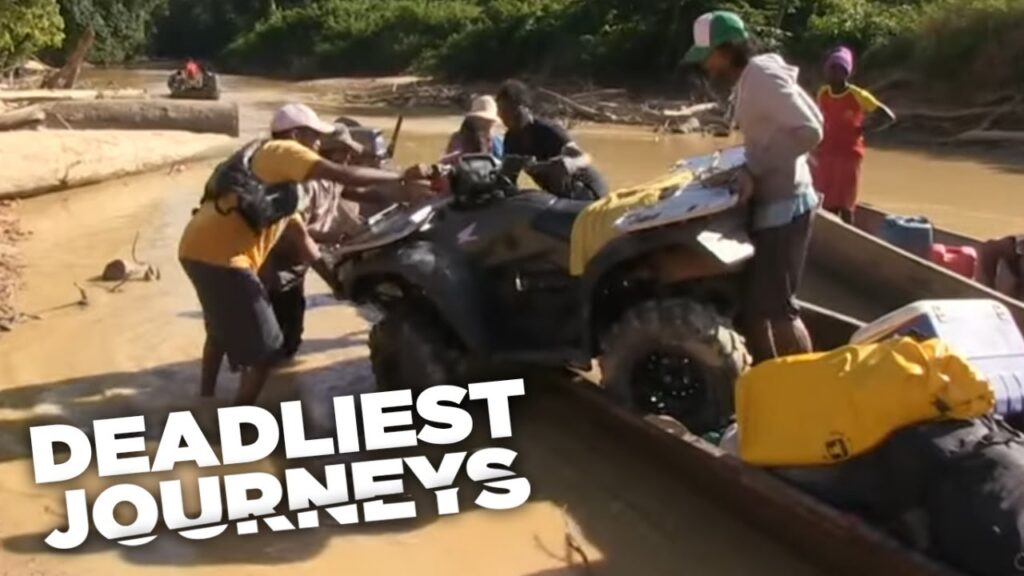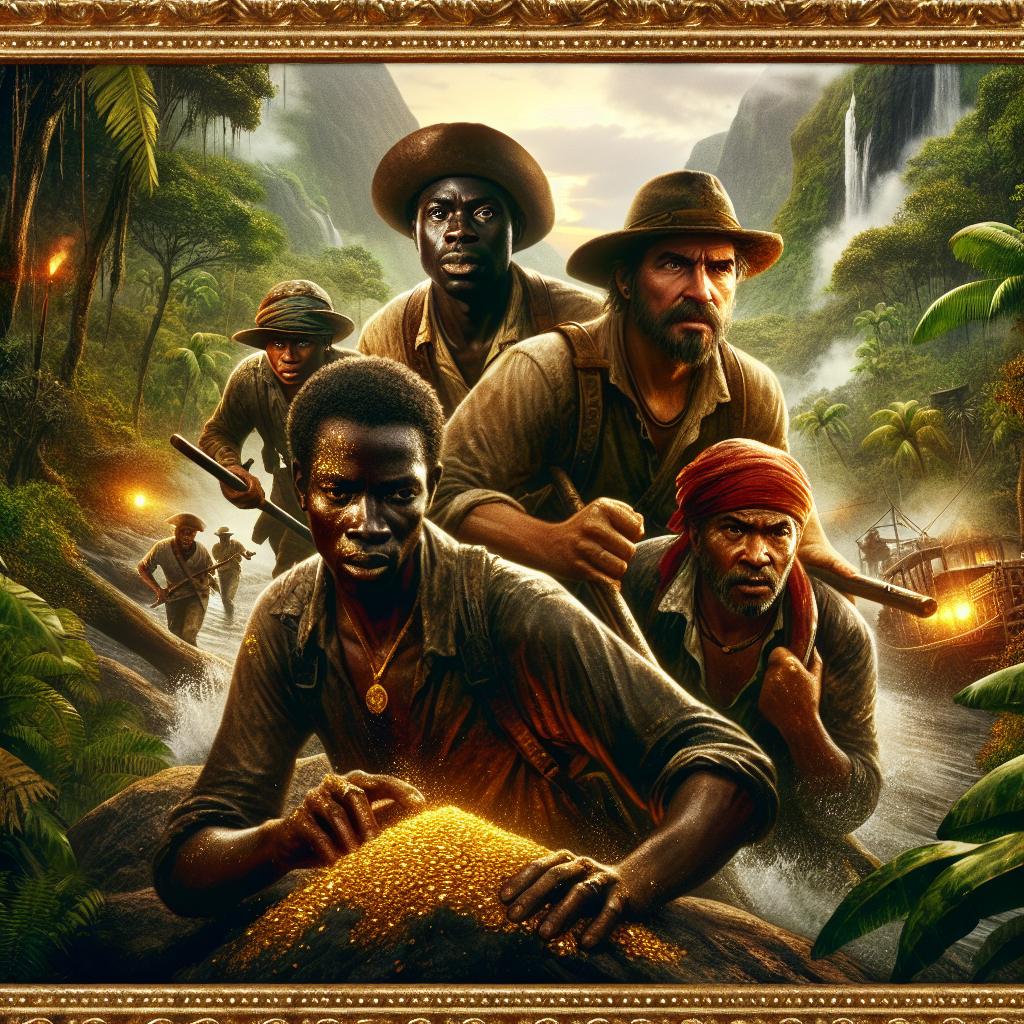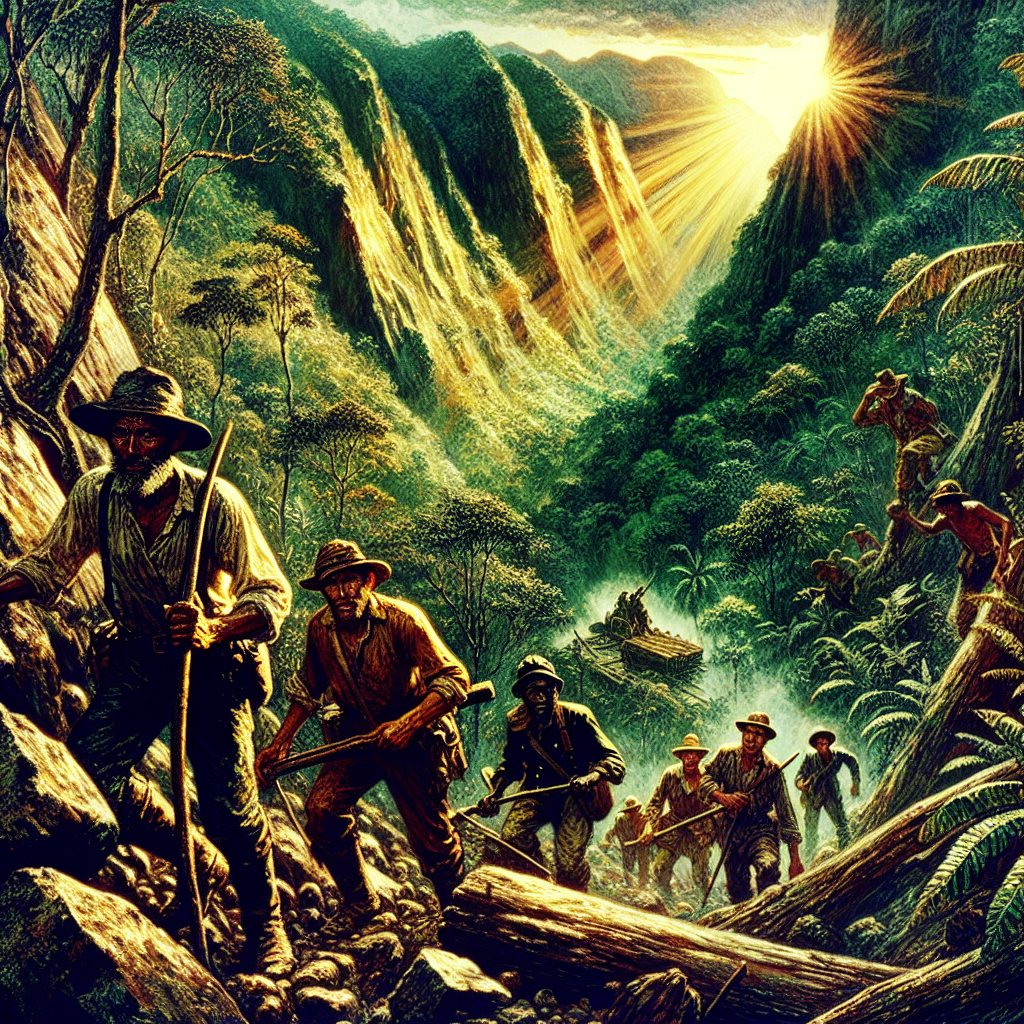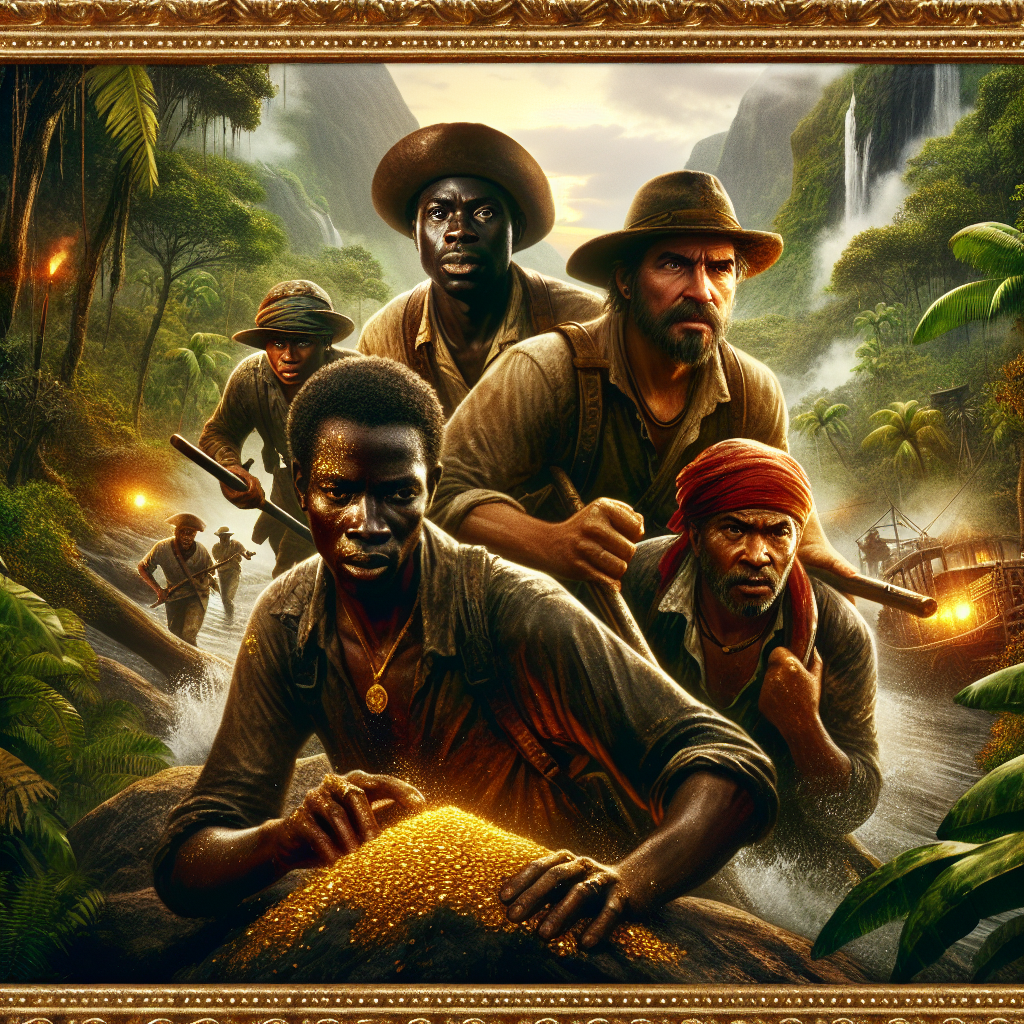In the documentary “Deadliest Journeys – Suriname, For a Fistful of Gold,” Pedro and Francesca, gold hunters in Suriname, embark on an annual journey deep into the Amazon forest. Suriname, a jungle country with minimal infrastructure, poses numerous challenges for the couple, including navigating treacherous rivers and overcoming the obstacles of living and working in such a remote and unforgiving environment. The documentary sheds light on the couple’s remarkable journey, the sacrifices they make, and the potential environmental consequences of gold mining in the region.
As Pedro and Francesca set off on their expedition, they carry with them the hopes of securing a better future for their family. Their adventure takes them through dense forests and unpredictable river currents, offering a glimpse into the lives of those who rely on nature’s resources for their livelihood. With breathtaking visuals and a captivating narrative, the documentary showcases the resilience and determination of two individuals risking it all in pursuit of a fistful of gold.
Best Deals to Surinam by BOOKING.COM
The Journey Begins
Introduction to Pedro and Francesca
In the heart of the Amazon forest lies Suriname, a jungle country known for its gold mining ventures. Among the intrepid gold hunters are Pedro and Francesca, a couple who embark on an annual journey into the depths of the jungle in search of their prized treasure. While most grandparents enjoy a peaceful retirement, Pedro and Francesca defy the norm and set off for months at a time to pursue their adventure. Their journey is fueled by a desire to provide a better future for their family, using the proceeds from their gold mining endeavors to secure their grandchildren’s education. The couple’s dedication to their mission is evident as they prepare their belongings and gather their supplies for the arduous journey ahead.
Suriname: A Jungle Country in the Amazon
Suriname, located in the heart of the Amazon, is a hidden gem that is difficult to locate on a map. Spanning 163,000 square kilometers, this jungle country is covered with lush forests and limited roads. With a population of just half a million, Suriname is the least populated country in the Americas, allowing adventurers like Pedro and Francesca to immerse themselves in its natural beauty without the distractions of a bustling city. Suriname is a land of adventure, with its rivers acting as the primary route of transportation. Canoes serve as the country’s trucks, navigating the unpredictable waters and providing a lifeline for those brave enough to explore the jungle.
The Couple’s Annual Gold Hunting Trip
Pedro and Francesca embark on their gold hunting trip, venturing deep into the Surinamese jungle. Their journey will last several days and cover approximately 200 kilometers, taking them through treacherous terrain and countless obstacles. The couple’s determination to secure their future drives them forward, knowing that the rewards of their labor will not only benefit their own family but also contribute to Suriname’s economy. As they set off on their journey, Pedro and Francesca remain optimistic, ready to face the challenges that lie ahead.
Navigating the Rivers
The Importance of Rivers in Suriname
In a country with limited road infrastructure, the rivers of Suriname play a crucial role in transportation. These waterways serve as the lifeline for indigenous communities, providing a means to travel between villages, transport goods, and embark on jungle expeditions. Canoes become the trucks of Suriname, ferrying people and supplies across the treacherous waters. The rivers are not only a means of survival but also a symbol of the Surinamese way of life, instilling a sense of connection and unity among the communities that rely on them.
Challenges of Navigating the River
While rivers provide vital transportation routes, navigating through them poses numerous challenges. The dense vegetation and unpredictable waters make it difficult to anticipate the currents, rocks, and sandbars that lie beneath the surface. As Pedro and Francesca venture deeper into the jungle, they must be vigilant, constantly on the lookout for potential obstacles that could halt their progress. The couple’s expertise in river navigation is put to the test as they maneuver through winding channels, relying on their knowledge and intuition to safely reach their destination.
Getting Stuck on Sandbars
One of the greatest challenges of navigating the rivers is the risk of getting stuck on sandbars. These shallow areas of the river can prove treacherous, causing boats to become stranded and progress to come to a grinding halt. When Pedro and Francesca’s overloaded canoe becomes stuck on a sandbar, panic ensues as they desperately try to free themselves. With the water level dropping due to a severe drought, the situation becomes dire. However, through quick thinking and teamwork, they manage to re-float the boat and continue their journey, grateful for their narrow escape.
Avoiding Rocks and Rapids
As Pedro and Francesca progress along the river, they must also contend with the constant threat of rocks and rapids. The silhouettes of jagged rocks hidden beneath the water’s surface pose a constant menace, as a collision could spell disaster for their canoe. Maneuvering through rapids requires skill and precision, as the powerful currents can quickly sweep away even the most experienced navigators. Constant vigilance and a deep understanding of the river’s behavior are crucial for Pedro and Francesca to avoid these hazards and safely reach their destination.

FIND YOUR BEST HOTEL IN SURINAM WITH BOOKING.COM
The People of Apoera
Apoera: A Remote Village in Suriname
Deep in the heart of the Surinamese jungle lies Apoera, a remote village that serves as a home for its resilient inhabitants. Surrounded by lush forests and nestled on the banks of the Corontan River, Apoera is a testament to the resilience and adaptability of those who choose to live in this untamed paradise. The villagers of Apoera have forged a unique way of life, navigating the challenges of their remote location with determination and resourcefulness.
Traveling by Boat for 24 Hours
Life in Apoera is a stark contrast to modern conveniences. To reach the nearby town of New Nickerie, the villagers endure a grueling twenty-four-hour boat journey along the treacherous river. This arduous expedition allows them to access vital supplies, connect with neighboring communities, and partake in commerce. The journey not only highlights the villagers’ perseverance but also underscores the importance of interdependence and collaboration as they work together to overcome the hardships presented by their remote location.
Reaching New Nickerie for Shopping and Supplies
New Nickerie serves as a lifeline for the villagers of Apoera, offering a glimpse of the outside world and essential resources. The bustling town provides access to markets, where villagers can purchase provisions such as flour, vegetable oil, and coffee to sustain their families for the coming month. The monthly trip to New Nickerie is a testament to the villagers’ resilience and resourcefulness, as they navigate the crowded streets and bustling markets to secure the supplies needed to sustain their village.
Overcoming Obstacles: Mud and Low Tides
The journey from Apoera to New Nickerie is not without its challenges, with villagers encountering obstacles such as muddy paths and low tides. The muddy terrain poses a significant hurdle, often causing vehicles to get stuck and forcing passengers to rely on their strength and determination to continue. Similarly, low tides can hinder the accessibility of the boat pier, requiring villagers to navigate treacherous mudflats and carefully traverse the difficult terrain en route to their destination. Despite these obstacles, the villagers of Apoera demonstrate resilience and tenacity, overcoming adversity to ensure the prosperity of their community.
Langu and Their Monthly Fuel Delivery
Langu: A Village in the Jungle
Nestled deep within the dense Surinamese jungle lies Langu, a village that relies on an intricate system of survival and sustainability. Cut off from urban developments and modern amenities, Langu’s inhabitants have learned to thrive amidst nature’s challenges, forging a harmonious existence with their environment. With no roads connecting them to the outside world, their isolated location means they must rely on monthly deliveries to sustain their community.
Dependence on Monthly Fuel
Fuel is a lifeline for the villagers of Langu, ensuring their survival and enabling them to power their generator. The generator, in turn, provides essential electricity for daily activities such as lighting, charging devices, and operating machinery. With no access to nearby petrol stations or frequent deliveries, the villagers must meticulously plan and ration their fuel usage to ensure it lasts until the next delivery. Fuel scarcity poses a significant threat to the community, as it affects their ability to communicate, maintain vital equipment, and sustain their way of life in the heart of the jungle.
Fuel Delivery via Canoe
The monthly fuel delivery is a lifeline for the villagers of Langu, ensuring their community’s survival and enabling them to continue their daily activities without interruption. The arrival of the fuel-laden canoe is a momentous occasion, eagerly awaited by the villagers. The canoe carries with it not only barrels of fuel but also a sense of hope and relief as it symbolizes their connection to the outside world. The villagers come together to unload the precious cargo, their collective effort showcasing their resilience and unity in the face of challenges.
Powering the Generator and Sustaining the Village
Once the fuel has been delivered, the villagers of Langu must prioritize its allocation to power their generator effectively. Every drop counts, as it determines the extent to which the village can access electricity for their daily needs. The generator is a vital source of power, allowing the villagers to charge their devices, power essential machinery, and illuminate their homes during the dark jungle nights. The careful management of fuel plays a crucial role in the village’s sustainability, ensuring that their lives continue to revolve around the heartbeat of their remote jungle community.

Challenges and Sacrifices in the Jungle
Living and Working in the Jungle
Living and working in the dense jungles of Suriname presents a unique set of challenges that can be both physically demanding and mentally taxing. Pedro and Francesca, as well as the villagers of Apoera and Langu, face a multitude of obstacles as they navigate this harsh environment. From extreme isolation and limited access to resources to the unpredictable weather conditions and wildlife encounters, life in the jungle requires constant adaptability and resilience. These individuals have chosen to embrace the jungle as their home, sacrificing modern comforts for a deep connection with nature and a chance at securing a better future.
Facing Isolation and Limited Resources
The remoteness of their locations leaves Pedro and Francesca, as well as the villagers of Apoera and Langu, vulnerable to isolation and a lack of resources. Limited access to medical care, educational facilities, and basic amenities poses significant challenges for these individuals. They must rely on their resourcefulness and the support of their communities to overcome these obstacles. Everyday tasks that are taken for granted in more urban settings become intricate puzzles that require creativity and determination to solve. However, the resilience and determination of those living in the jungle ensure that they can thrive despite the isolation and scarcity they face.
Surviving the Harsh Climate and Wildlife
The unpredictable climate of the Surinamese jungle presents a constant challenge for Pedro and Francesca and the communities of Apoera and Langu. Extreme heat, torrential rains, and dense humidity can take a toll on both physical and mental well-being. Furthermore, the jungle is home to a diverse array of wildlife, some of which can pose significant threats to human inhabitants. Navigating through dense vegetation and encountering potentially dangerous animals require a deep understanding of the jungle’s ecosystem and a respect for its delicate balance. The resilience and adaptability of those who call the jungle home are put to the test as they coexist with nature’s most formidable forces.
The Dark Side of Gold Mining
Gold Mining in Suriname
The pursuit of gold comes at a cost, and in Suriname, this cost manifests in various forms. Gold mining in the country is a lucrative industry, attracting thousands of men from neighboring countries in search of their fortunes. However, the lure of gold often leads to environmental destruction, the exploitation of natural resources, and the displacement of indigenous communities. Suriname’s jungle, known for its rich deposits of gold, becomes a battleground where human greed clashes with the need for sustainable practices and the preservation of delicate ecosystems.
Environmental Destruction
Gold mining in Suriname has dire consequences for the environment, with deforestation and pollution being prevalent issues. Mining operations often involve the use of destructive techniques such as hydraulic mining, which involves using high-pressure water jets to dislodge soil and release gold particles. This indiscriminate method of extraction leads to the destruction of vast areas of pristine rainforest, disrupting ecosystems and threatening biodiversity. Additionally, the use of mercury in the gold extraction process further contributes to environmental degradation, contaminating waterways and endangering both human and animal health.
Effect on Indigenous Communities
The impact of gold mining on indigenous communities in Suriname cannot be overlooked. The encroachment of mining operations on ancestral lands disrupts the delicate balance of these communities, forcing them to relocate and abandon their traditional ways of life. The loss of land and resources has severe cultural implications, as indigenous communities are deeply connected to their surroundings and rely on the jungle for their sustenance and livelihoods. The lure of gold often creates conflicts between indigenous communities and miners, further exacerbating the challenges faced by these marginalized groups.

Road Construction and its Impact
The Need for Roads in Suriname
The limited road infrastructure in Suriname poses significant challenges for transportation and connectivity. With most areas accessible only by rivers, the need for roads becomes apparent. Improved road networks would facilitate the movement of people, goods, and services, linking remote villages and urban centers. Roads would not only enhance accessibility but also promote economic growth, as they provide opportunities for trade and development. However, the construction of roads in the dense Surinamese jungle is no easy feat, presenting numerous obstacles and potential dangers.
Construction Challenges in the Jungle
Building roads in the jungle requires navigating through impenetrable vegetation, uneven terrain, and unpredictable weather conditions. The thick foliage must be cleared, and the land must be leveled to accommodate the road’s path. The use of heavy machinery becomes necessary, further adding to the complexities of construction. The isolated location of these road projects makes it challenging to transport materials and equipment, further increasing costs and logistical issues. Despite these challenges, the development of roads is seen as a vital step towards improving accessibility and fostering economic growth in Suriname.
Impact on the Environment and Wildlife
Road construction in the jungle can have severe environmental impacts, causing deforestation, habitat destruction, and loss of biodiversity. The process of clearing land for road construction disrupts delicate ecosystems and displaces wildlife, forcing them to seek new habitats or perish. The cumulative effect of road development can fragment forests, isolating animal populations and hindering their ability to roam freely. Additionally, increased road traffic and human activity can result in higher levels of pollution, further degrading the natural environment. Balancing the need for road infrastructure with environmental preservation becomes a complex task that requires careful planning and consideration.
Preserving the Jungle and its People
Importance of Conservation in Suriname
Preserving the Surinamese jungle and safeguarding its natural resources is crucial for the well-being of both its inhabitants and the global community. The vast expanse of untouched rainforest is a treasure trove of biodiversity, with countless species yet to be discovered. Protecting this unique ecosystem is not only an ethical responsibility but also essential for mitigating climate change and ensuring the availability of natural resources for future generations. Conservation efforts in Suriname must focus on sustainable practices that balance economic development with environmental protection, allowing both nature and people to thrive.
Balancing Economic Development and Environmental Protection
The challenge lies in striking a delicate balance between economic development and environmental sustainability. Suriname’s gold mining industry, for example, can be a source of economic prosperity. However, it must be closely regulated to minimize its environmental impact and ensure the welfare of indigenous communities. Encouraging responsible mining practices, such as the use of environmentally friendly extraction techniques and proper waste management, can help mitigate the negative consequences of this industry. Additionally, promoting alternative livelihoods and sustainable economic activities can offer viable alternatives that benefit both individuals and the environment.
Sustainable Practices and Alternative Livelihoods
Promoting sustainable practices and alternative livelihoods is crucial for the long-term well-being of Suriname’s jungle and its inhabitants. For communities like Apoera and Langu, exploring opportunities beyond gold mining can foster economic diversity and reduce dependency on extractive industries. Investing in eco-tourism, sustainable agriculture, and craft-based enterprises can create sustainable income sources while simultaneously preserving the natural environment. These alternative livelihoods not only have minimal ecological impact but also celebrate and highlight the cultural heritage of Suriname’s indigenous communities.
Conclusion
The journey of Pedro and Francesca through the Surinamese jungle provides a glimpse into the challenges faced by those who venture into this untamed wilderness. The couple’s annual gold hunting trip serves as a testament to their resilience, determination, and unwavering dedication to securing a better future for their family. As they navigate treacherous rivers, overcome isolated locations, and face the harsh realities of working in the jungle, Pedro and Francesca exemplify the indomitable spirit of Suriname’s people.
Their journey also sheds light on the dark side of gold mining, highlighting the environmental destruction and the impact on indigenous communities. The need for road infrastructure further underscores the delicate balance between economic development and environmental preservation. However, through conservation efforts, sustainable practices, and fostering alternative livelihoods, Suriname has the potential to create a future where economic prosperity and environmental protection coexist harmoniously.
As we reflect on Pedro and Francesca’s journey, we are reminded of the importance of preserving the Surinamese jungle and its people. The challenges they face serve as wake-up calls, calling us to action to protect and celebrate the beauty and diversity of this unique ecosystem. By embracing sustainable practices, supporting alternative livelihoods, and fostering a deep appreciation for nature, we can ensure that the Surinamese jungle continues to thrive for generations to come.
